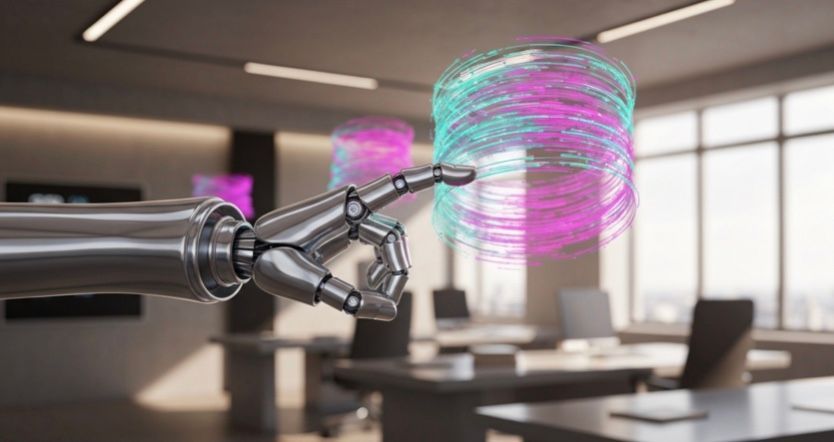RPA Solutions: Choosing the Right Software for You
RPA Solutions: Choosing the Right Software for You

Key Highlights
● Robotic process automation (RPA) uses software bots to automate repetitive digital tasks.
● Implementing RPA solutions can significantly boost productivity, accuracy, and cost savings.
● RPA technology works alongside AI to enable intelligent business process automation.
● Key features to look for in RPA software include scalability, security, and ease of use.
● Successful process automation requires a clear strategy, from process discovery to deployment.
● RPA is transforming industries like finance, healthcare, and manufacturing with targeted applications.
Are you looking for ways to make your business more efficient? In today's fast-paced world, embracing digital transformation is key to staying competitive. One of the most powerful tools at your disposal is robotic process automation. These automation solutions can handle the repetitive parts of any business process, freeing up your team to focus on what truly matters. This guide will walk you through what RPA is, how it works, and how to choose the right software for your needs.
How RPA Enhances Workflow Automation in Businesses
Understanding Robotic Process Automation (RPA)
Robotic process automation (RPA) is a software technology designed to automate digital tasks quickly and reliably. Think of it as a digital workforce that can execute a business process without needing human intervention. These software "bots" are programmed to follow specific rules to complete tasks with speed and accuracy.
This form of process automation is a core element of any digital transformation strategy. By handling high-volume, repetitive work, RPA helps organizations scale their operations efficiently. Let's explore what RPA means for modern businesses and how it stands apart from other automation methods.
What is RPA in Modern Business Environments?
In a modern business setting, robotic process automation refers to using software robots, or "bots," to handle digital tasks that people usually perform. This method of business process automation is perfect for repetitive tasks like extracting data, filling out forms, or transferring files. Essentially, RPA bots mimic human actions on a computer.
The great thing about RPA tools is their simplicity. You don't need advanced coding skills to set them up. Modern RPA platforms allow you to configure workflows intuitively, often with drag-and-drop interfaces. If you can record a video on your phone, you can likely set up an RPA-driven workflow.
This accessibility makes RPA a powerful tool for any organization looking to streamline its operations. It allows you to automate high-volume work reliably, freeing your employees from monotonous tasks and letting them focus on more strategic initiatives that require human creativity and insight.
How RPA Differs from Traditional Automation Tools
RPA technology takes a unique approach compared to traditional automation tools. Older automation technology often required complex coding and deep integration into a company's backend systems. This made creating an automation program a lengthy and expensive project reserved for IT specialists.
In contrast, RPA bots work on the front end, interacting with applications and systems through their user interfaces, just like a human would. This means RPA can automate digital tasks across different applications, including legacy systems, without needing to change the underlying software. It acts as a virtual user, clicking, typing, and navigating through screens.
This distinction offers several advantages:
● Faster Implementation: RPA can be deployed more quickly since it doesn't require extensive system changes.
● User-Friendliness: Many RPA platforms are low-code or no-code, allowing business users, not just developers, to build automations.
● Flexibility: RPA bots can easily connect with various applications, making them highly adaptable to existing workflows.
Core Technologies Behind RPA Solutions
While basic RPA is a rule-based form of software robotics, its true power is unlocked when combined with other advanced technologies. Modern RPA solutions often incorporate artificial intelligence (AI) and machine learning to handle more complex scenarios. This evolution is often called intelligent automation.
Technologies like computer vision allow bots to "see" and interact with on-screen elements, while other AI components help them understand and process unstructured data. Let's look closer at how software bots and AI work together and how they integrate with your existing systems.
The Role of Software Bots and AI in RPA
Software bots, or RPA robots, are the workhorses of robotic process automation. On their own, they are purely process-driven, following predefined rules to a tee. They excel at replicating human-driven tasks like copying and pasting data or filling out forms with perfect accuracy.
However, when you combine these bots with artificial intelligence and machine learning, their capabilities expand dramatically. AI gives them cognitive abilities, allowing them to handle tasks that require more than just following a script. For instance, they can learn from data, make decisions, and even understand natural language.
This combination, known as intelligent automation, allows RPA to tackle more complex use cases. Generative AI, for example, can help create automations automatically or enable bots to self-heal when an application's interface changes, making the entire system more resilient and powerful.
Integrations with Existing Enterprise Systems
One of the defining features of RPA solutions is their ability to work with the systems you already have. Unlike traditional automation that requires deep, code-level integration, RPA works through the user interfaces of your digital systems. This makes it application-agnostic, meaning it can operate across various enterprise applications.
This capability is especially valuable for companies that rely on legacy systems. Instead of undertaking a costly and risky project to replace old software, you can use RPA to bridge the gap between your legacy and modern applications, automating processes that span both.
RPA's integration strengths include:
● Working with User Interfaces: RPA bots interact with applications just as a person does, clicking buttons and typing in fields.
● Connecting to APIs: Besides UI interactions, RPA can also connect to APIs to execute processes and transfer data between systems.
● No Changes to Underlying Systems: You can implement RPA without altering your existing IT infrastructure, which reduces risk and speeds up deployment.
Essential Benefits of Implementing RPA
Implementing RPA delivers a positive snowball effect on your business operations. You'll see immediate, measurable benefits like significant cost savings and a sharp reduction in human error. As you expand your RPA implementation, these advantages multiply, boosting productivity across your entire organization.
The benefits extend beyond just numbers. Automating tedious tasks frees your business users to focus on more fulfilling and strategic work, which can improve employee satisfaction and innovation. Now, let’s explore how RPA boosts efficiency and enhances compliance.
Boosting Organizational Productivity and Efficiency
A primary benefit of RPA is the dramatic increase in productivity. Software bots can work 24/7 without breaks, completing routine tasks much faster than a human ever could. A business process that once took hours can be completed in minutes, drastically cutting down processing times for various business functions.
This speed and efficiency directly translate into lower operational costs. Since bots handle high-volume work more effectively, you can reallocate your human workforce to higher-value activities that drive growth. This allows your teams to focus on problem-solving, strategic planning, and building customer relationships.
By automating tasks across different departments, RPA breaks down technology silos and creates seamless workflows. This enterprise-wide efficiency gain ensures that your entire organization operates more smoothly, delivering results faster and more reliably while improving your bottom line.
Enhancing Accuracy and Compliance in Processes
Everyone makes mistakes, especially when performing monotonous tasks like data entry over long periods. A major advantage of process automation is the near-elimination of human error. As long as RPA bots are programmed correctly, they perform tasks with 100% accuracy every single time.
This heightened accuracy is crucial for maintaining compliance. In industries with strict regulatory standards, such as finance and healthcare, RPA can ensure that processes are followed exactly as prescribed. This reduces the risk of costly errors and protects sensitive data.
The benefits for accuracy and compliance include:
● Guaranteed Consistency: Bots follow rules without deviation, ensuring predictable and uniform results.
● Reduced Human Error: Automating tasks like report generation and data entry prevents common mistakes.
● Complete Audit Trails: RPA systems generate detailed logs of every action taken, making it easy to prove compliance and conduct audits.
● Strengthened IT Security: Automation can protect sensitive data by minimizing human access and associated risks.
Most Common RPA Applications in Real Businesses
RPA solutions excel at executing manual and repetitive tasks, making them a game-changer in nearly every industry. From finance departments automating invoice processing to healthcare providers sending appointment reminders, the use cases are vast. This automation technology is transforming business process management by saving time and cutting costs.
When you extend RPA tools with AI on a unified automation platform, you can tackle even more complex workflows, unlocking greater transformational value. Let’s look at some specific examples in finance and customer service.
Examples of RPA in Finance and Accounting
The financial services sector is a prime candidate for RPA due to its reliance on rule-based, data-heavy processes. Banks and financial institutions use RPA software to automate tasks like customer onboarding, where bots can quickly collect and verify information, significantly reducing processing time.
Another common application is in loan processing. RPA can handle the data entry and document checks required for credit assessments, leading to faster and more accurate decisions. For instance, KeyBank used RPA for mortgage quality checks and completed nine years' worth of work in just two weeks.
Furthermore, RPA plays a vital role in compliance and report generation. By automating the gathering and processing of data for regulatory reports, financial firms can reduce the risk of human error and ensure they meet all requirements. This makes business process management in finance more secure and efficient.
Use Cases for RPA in Customer Service & Support
In customer service, RPA helps organizations increase efficiency while simultaneously delighting customers. Automating routine inquiries is a common use case, where chatbots powered by RPA can provide instant answers to simple questions about order status or account information. This frees up human agents for more complex issues.
Another valuable application is in ticket and issue resolution. When a customer complaint comes in, RPA can automatically log it, categorize it, and route it to the right customer support team. This simple process discovery and automation can dramatically reduce response times and improve the overall customer experience.
RPA streamlines many customer-facing processes:
● New Customer Onboarding: Automating data entry and verification creates a faster, smoother experience for new clients.
● Feedback Management: Bots can automate the collection and analysis of customer feedback, helping you improve services more quickly.
● Inquiry Handling: RPA can direct complex inquiries to the right agents, ensuring customers get the help they need without delay.
Industries Most Impacted by RPA Technology
RPA technology is making a significant impact across a wide range of industries by automating everything from human resources tasks to inventory management. Through intelligent process automation, companies are discovering new efficiencies and transforming their operations. Tools like process mining help identify the best opportunities for automation.
From healthcare to manufacturing, organizations are leveraging RPA to reduce administrative burdens and improve productivity. Below, we'll examine how RPA is being adopted in healthcare and how it's revolutionizing the manufacturing and supply chain sectors.
RPA Adoption in Healthcare and Life Sciences
In the healthcare industry, RPA is injecting much-needed operational efficiency, reducing the administrative burden on human workers, and allowing them to focus on personalized patient care. One UK hospital network, for example, saved 7,000 hours per year by implementing RPA robots to handle routine tasks.
Common automation solutions in healthcare include patient scheduling, where RPA can automate appointment bookings, reminders, and cancellations. This improves patient access to care and reduces no-show rates. Process mining can help hospitals identify these and other high-impact areas for automation.
RPA is also invaluable for claims processing, where it automates patient information verification and submissions to shorten reimbursement cycles. In addition, RPA bots can manage patient data by extracting and inputting information from multiple sources into electronic health records, ensuring data accuracy and compliance.
RPA Transformations in Manufacturing and Supply Chain
From the factory floor to the back office, RPA is transforming business operations in manufacturing and the supply chain. As a key part of digital transformation efforts, RPA helps reduce costs, improve productivity, and accelerate time-to-market by automating critical processes.
For example, in inventory management, RPA bots can monitor stock levels, automate reordering, and reconcile inventory data to prevent shortages or overstock situations. In order processing, RPA automates handling purchase orders and invoices, which improves accuracy and fulfillment times. The manufacturing company Stant used RPA to achieve 80% straight-through invoice processing.
RPA is impacting manufacturing and supply chain in several ways:
● Order Processing: Automating purchase orders, invoices, and shipment tracking for better accuracy.
● Inventory Management: Monitoring stock levels and automating reorder processes.
● Quality Control: Automating data collection and analysis for product inspections.
● Maintenance Management: Scheduling preventive maintenance and tracking equipment performance to reduce downtime.
Evaluating Key Features in RPA Software
Choosing the right RPA software is critical to the success of your process automation initiatives. You'll want to look for automation solutions that are not only powerful but also easy for your team to use. A platform with intuitive user interfaces will encourage wider adoption and help you scale faster.
Features that support intelligent automation, such as AI integration, are also important for future-proofing your investment. Let's examine some essential features like scalability and security, as well as capabilities for analytics and management.
Scalability, Security, and Ease of Use
When evaluating RPA software, three features stand out: scalability, security, and ease of use. Scalability is crucial because your automation needs will grow over time. Choose a platform with an infrastructure that can handle an increasing number of bots and workloads without a drop in performance.
Security is non-negotiable. Top-tier software tools will have robust security architecture and certifications to protect your sensitive data. An RPA solution should strengthen your security posture by providing detailed audit trails and eliminating risks associated with human error.
Finally, prioritize ease of use. The best RPA software offers low-code or no-code development options, making it accessible to both technical and non-technical users. This empowers more employees to create automations, which accelerates adoption and maximizes your return on investment.
Analytics, Management, and Support for Intelligent Automation
Beyond the basics, effective RPA tools provide strong support for management and analytics. You need to be able to monitor your bots, track their performance, and measure the ROI of your intelligent automation efforts. Good analytics features give you the data needed to optimize processes and refine your strategy over time.
Centralized management and governance are also key. Look for a platform that allows you to configure, monitor, and manage all your automated processes from one place. This ensures consistency and compliance as you scale your automation program. Robust support from the vendor, including training and an active community, can also significantly impact your success and customer satisfaction.
Here are some key features to look for:
| Feature | Description |
|---|---|
| Analytics | Track bot performance, uptime, and ROI to optimize processes and refine automation strategies. |
| Management | Includes features for monitoring, configuration, and governance of all your automated processes. |
| Vendor Support | Look for robust customer support, comprehensive training programs, and an active community to guide your journey. |
| AI Integration | Choose vendors that invest in AI-driven features to improve automation efficiency and adaptability. |
Top RPA Software Providers in the U.S. Market
The market for RPA software is dynamic, with many providers offering a range of software tools and capabilities. When starting your search for process automation solutions, it's helpful to know who the major players are. Some vendors offer comprehensive enterprise-level platforms, while others focus on more specialized solutions.
Understanding the landscape will help you find an automation platform that fits your specific needs and long-term goals. Let's review some of the leading platforms for enterprises and the criteria you should use to compare them.
Overview of Leading Platforms for Enterprises
When it comes to enterprise-grade RPA software, a few names consistently lead the market. Providers like Automation Anywhere and UiPath are known for their comprehensive platforms designed to meet the complex needs of large organizations. These solutions offer extensive integrations with other enterprise applications and have robust partner ecosystems.
These leading software tools are built for scale and include powerful AI capabilities that work with RPA technology to automate dynamic and complex business processes. They also provide strong training programs and support to help companies successfully deploy and manage their automation initiatives enterprise-wide.
In addition to these leaders, other vendors like ServiceNow and SAP offer RPA tools purpose-built for their own ecosystems. While useful, they may be less suitable as standalone solutions compared to the more comprehensive enterprise platforms.
Comparison Criteria: Pricing, Capabilities, and Customization
When comparing RPA solutions, it's essential to look beyond the brand names and evaluate them based on criteria that match your business needs. Pricing is a major factor. Look for vendors with transparent cost structures that won't surprise you as you scale. Flexible pricing, such as options for unlimited bot usage, can be very beneficial.
The capabilities of the platform are equally important. Does the solution support both attended and unattended automation? Can it integrate seamlessly with your existing systems? Prioritize vendors that are committed to innovation and continuously enhance their RPA capabilities with AI and other advanced features.
Consider these key comparison points:
● Pricing: Seek transparent and flexible models that align with your growth plans.
● Capabilities: Ensure the platform supports various automation types and integrates with your current technology stack.
● Customization: The right solution should be flexible enough to adapt to your unique workflows and business goals.
● Support: Evaluate the vendor's training programs, customer support, and community engagement to ensure a successful partnership.
Overcoming Challenges When Implementing RPA Solutions
While the benefits of RPA are clear, the journey of an RPA implementation can present some challenges. Many organizations struggle with identifying the right business process to automate or optimizing existing workflows before deployment. Without a clear strategy and adherence to best practices, automation solutions can fail to deliver their full potential.
Proactively addressing these potential hurdles is key to a successful process automation program. By thoroughly assessing your business needs, engaging stakeholders early, and selecting the right vendor, you can navigate the path to deployment smoothly. Understanding common obstacles and how to avoid them will set you up for long-term success.
Common Obstacles and Best Practices for Deployment
One of the first obstacles in an RPA implementation is simply discovering which processes to automate. Organizations often struggle to accurately map their existing workflows, leading to missed opportunities.A best practice is to use an RPA platform with integrated process discovery tools to identify and document tasks ripe for automation.
Another common issue is a lack of proper governance. Without clear standards, automation practices can become inconsistent, which undermines scalability and introduces risk. Establishing a Center of Excellence (CoE) to oversee the entire process automation lifecycle ensures compliance, security, and continuous improvement.
To ensure a smooth deployment, follow these best practices:
● Engage Stakeholders Early: Put human needs at the center of your planning and involve leaders who can champion the change.
● Start with a Solid Foundation: Create a CoE to establish standards for quality and governance.
● Choose the Right Vendor: Select a partner that aligns with your long-term business goals and offers robust support.
● Measure and Refine: Track KPIs like bot performance and ROI to continuously optimize your automations.
Conclusion
In conclusion, selecting the right RPA solution can significantly transform your business processes and enhance operational efficiency. By understanding the core technologies, benefits, and challenges associated with RPA, you can make well-informed decisions that align with your organizational needs. Whether you're in finance, healthcare, or manufacturing, RPA is tailored to offer scalable solutions that drive productivity and accuracy. Embrace the power of automation today, and let it pave the way for a more streamlined and efficient future in your business operations. For personalized guidance on choosing the best RPA software for your needs, don't hesitate to reach out for a free consultation!
Frequently Asked Questions
What kinds of business processes are best suited for RPA automation?
The best business process candidates for automation solutions are those that are highly repetitive, rule-based, and involve structured digital data. Tasks like data entry, filling out forms, and generating standard reports are ideal because they require minimal human intervention and follow a predictable workflow, making them perfect for RPA.
Do companies need coding skills to deploy RPA software?
No, coding skills are generally not required to deploy modern RPA software. Many automation solutions feature user-friendly, low-code or no-code software tools with drag-and-drop interfaces. This empowers business users and other human workers, not just IT specialists, to build and deploy their own automations quickly and easily.
How should a business start its RPA journey?
A business should start its RPA implementation by identifying high-impact, low-complexity processes using tools like process discovery and process mining. Following best practices, establish clear goals, create a governance framework like a Center of Excellence, and start with small pilot projects to build momentum for your automation program.



